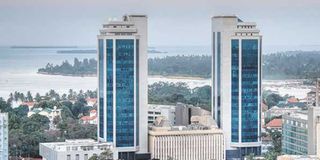Bank of Tanzania explains Sh320 billion expenditure

Bank of Tanzania headquarters. Photo|File
What you need to know:
The shrinking amount of foreign currency reserves at the Bank of Tanzania (BoT) is caused by external debt servicing as well as interventions of foreign exchange markets.
Dar es Salaam. The Bank of Tanzania (BoT) spent a total of $140 million (nearly Sh320 billion) in October on servicing foreign debt and stabilising foreign exchange market interventions through dollar sales.
The central bank’s director of economic research and policy, Dr Suleiman Missango, revealed this yesterday when responding to questions from The Citizen over the drop of foreign currency reserves in October when compared to September.
“We mostly spent the foreign exchange reserves on servicing debts which had reached their maturities, as well as mitigating the foreign exchange market during a shortage of dollars,” he told The Citizen in a telephone interview.
This comes after BoT’s Monthly Economic Review for November showed that the foreign currency reserves went down to $5,277.8 million, which translates 5.2 months of imports in October this year, from $5,437 million or 5.3 months of imports during September.
The review, which was posted on the central bank website yesterday showed that the reserve shrank by $140 million in October.
In August this year, the reserve held a total of $5,500 million, which was sufficient to cover 5.6 months of imports of goods and services.
The BoT November economic review showed that debt servicing was $23.9 million in October 2018, of which $13.5 million was principal repayment.
Cumulative debt service in the year to October 2018 amounted to $1,076.1 million, of which the principal repayment was $797.6 million and the balance was interest payment.
During the month under review, external debt, comprising public and private sector debts amounted to $20,759.1 million at the end of October 2018, an increase of $78.3 million and $1,644.8 million from previous month and corresponding month in 2017, respectively.
The increase is on account of new disbursements, accumulation of interest arrears and appreciation of the dollar against other currencies in which the debt is denominated.
Central government debt, which accounted for 76.5 per cent of the debt stock, increased by $52.6 million and $919.6 million from the levels recorded at the end of September 2018 and October 2017, respectively.
On foreign exchange interventions, the review showed that the Bank had remained active in the market for the purpose of managing liquidity and maintaining an orderly money market, with a net sale of $51.15 million compared to net sale of $13.75 million in September 2018.
That enabled the shilling to remain fairly stable against the dollar throughout the month, fluctuating in narrow ranges of Sh2.05 to an average of Sh2,289.92 per dollar in October 2018 compared with Sh2,287.80 per US dollar in the preceding month.




